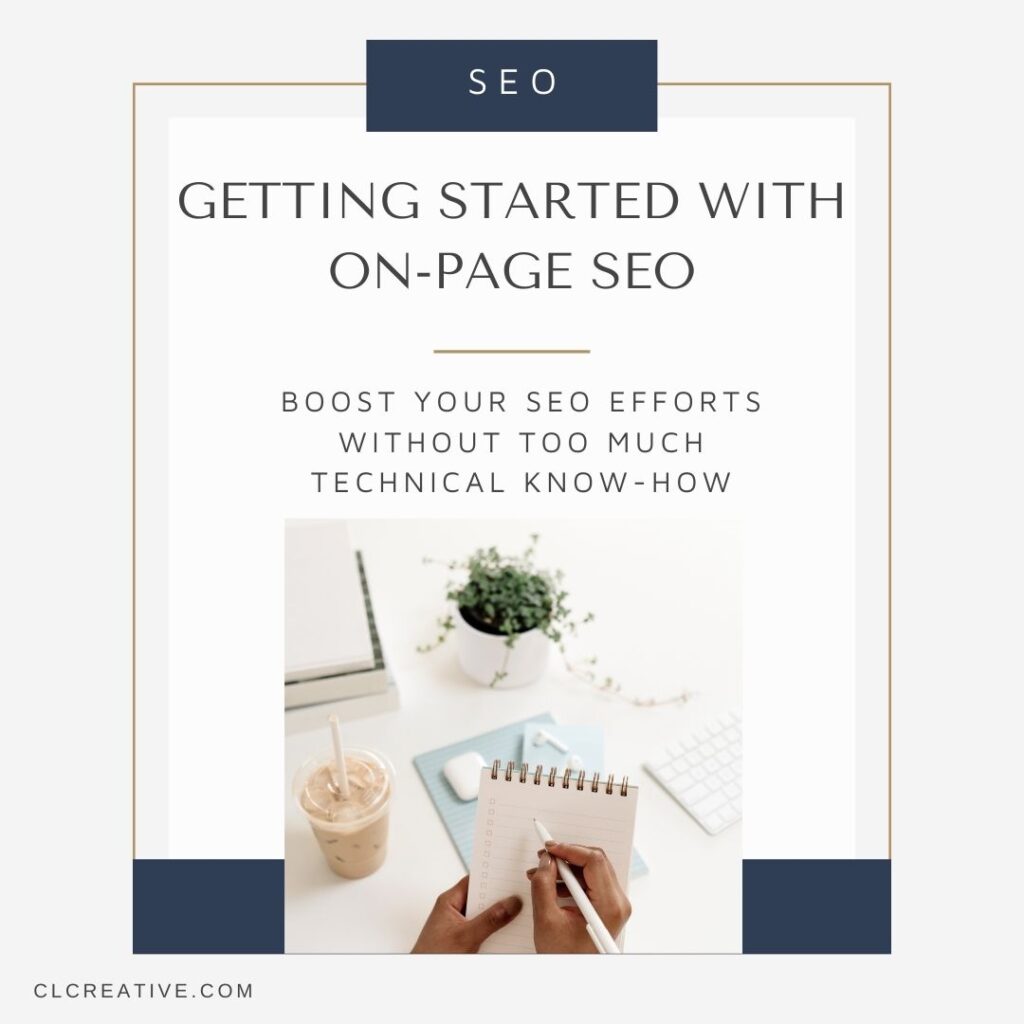
Last week kicked off a new blog series on SEO, discussing what SEO is all about and why anyone with a website needs it, but this week we’ll be taking a closer look at on-page SEO and how to get started implementing best practices for an efficient on-page SEO strategy.
This post will focus more on the non-technical part of on-page SEO, which I’ll talk about later in the series. The goal of this post is to get familiar with some of the on-page techniques that will boost your SEO efforts without too much technical know-how. Typical on-page SEO tactics include optimizing content (such as title and header tags, as well as images), internal links and URLs. If you make any content changes to your website, you can tackle some basic on-page SEO strategies.
Why Does On-Page SEO Matter?
On-page SEO is important because it directly affects how a search engine comprehends what your site is all about and if it is relevant to a user’s search query. That last part is bold because relevancy is a huge part piece of the algorithm puzzle. When search engine optimization first started out, the game was to just toss in your relevant keywords throughout the content of your site and call it good, but Google has evolved in such a way that keywords aren’t enough. They play a part, sure, but if you are searching for something, just having the keyword thrown all around doesn’t guarantee an answer to your query. Content optimization is where it’s at! Content optimization includes indicators like:
- How much time was spent on the page (bounce rates)
- Click-through-rate
- Relevancy to initial search query
- Page speed
- User experience
Google is now able to better understand what a user is specifically trying to find and showing the most relevant results that best match the intent of the user searching through indicators like content optimizations.
6 Key On-Page SEO Factors to Consider
High-Quality Content
Relevance content is arguably the most important parts of on-page SEO. It’s a balance of writing for the user and for search engines, but the overall goal is to match your content with the user’s search query. If they match up, people will stay on the site and click around and the search engines will notice.
It’s also more than just tossing around keywords at every opportunity. Fun fact: if you use the same keyword on multiple pages on your site, you’re likely to hurt your SEO efforts. You’re basically competing with yourself on each page. Not to mention that users can tell when content has keywords forced in there and the “bot-like” tone of voice isn’t enticing.
Be well-rounded in keywords for your content; select different keywords revolving around central ideas that are relevant to your topic and use them appropriately. When in doubt, remember that it’s more important to write for the user than it is the search engine. Content needs to be relevant and meet the user’s expectation of a solution to their query.
Headlines and Structure
Do you remember having to do outlines in school? Teachers gave you a topic for a report and part of the grade was creating the initial outline that would guide the contents of the report. Turns out, that was great practice for SEO-minded writing. When it makes sense, try to structure your content into outline form, like:
- Main Title of Post
- Sub Topic 1
- Item relating to sub topic 1
- Another item relating to sub topic 1
- Sub Topic 2
- Item relating to sub topic 2
- Conclusion
- Sub Topic 1
Part of the user experience is being able to readily find what info they are looking for and this structured format helps them do that.
Additionally, I recommend giving your topics proper headline tags (H1-H6). Google is using these headline tags to better understand the content and structure of the page. Putting your topic headlines (and subheadlines) into a structured format with H tags is ultimately a great method in structuring content that will serve your readers. They will spend time on your site reading the content and Google will recognize and reward that.
Image Optimization
I’ve discussed the importance of image optimization before because it’s a great way to boost your on-page SEO efforts. Optimized images are not only another opportunity to rank in Google (oh hi, Google Image Search) but they are also a great way to break up text, providing a better user experience, especially when they support your content. Perhaps most importantly, optimized images also load faster, which is a major factor for Google. So how do we optimize the images?
Give images appropriate filenames
These filenames give Google an idea about the content of the image so it’s important to rename IMG_12345.jpg into something more descriptive, like spaghetti.jpg. Remember to:
- Be descriptive
- Be brief
- Don’t stuff keywords in the filename (i.e., don’t name your image pasta-spaghetti-Italian-food-dinner-parmesan-cheese.jpg. A better approach would be bowl-of-spaghetti.jpg)
- Use dashes between words instead of underscores
Don’t forget the alt text
Alt text is short for alternative text. It’s commonly referred to as an ‘alt tag’, but it’s a brief bit of text used within HTML code to describe an image or image function. This is important for a few reasons, with web accessibility topping that list, but also benefits on-page SEO efforts. Proper alt text provides better image context for search engines, since they can’t technically crawl an image file, but can crawl the alt text, to determine the relevance of the image.
The same rules apply to alt text as they do files names: be descriptive, brief, and don’t keyword-stuff. In addition, there is no need to include “Image/Picture/Photo of…” in your alt text description.
Pay attention to image sizes
Large images slow down websites, full stop. It’s important to resize images appropriately and make sure you aren’t loading high-resolution (read: 300 dpi) photos. It’s not necessary for web. For WordPress users, I recommend uploading a photo that’s 2000 pixels wide and at 72 dpi (bonus points for files that are less than 1MB and double points for less than 500KB). From there, make use of WordPress’ native file size options for images when inserting the image in your post. Typically, once an image is uploaded, WordPress will create different size options (large, medium, thumbnail, etc.) and you can select which size makes sense for your use. You should not be uploading those different sizes yourself; that is just double-duty since WP does it automatically. This also gives you flexibility to use the same photo in another instance, without having to re-upload it again to suit the new instance.
Title Tag
Title tags are a bit of code in the <head> section of each web page. It’s not something you readily see on the webpage (though it’s often seen in the browser tab of the page) but it is visible on the SERP (search engine results page). The title tag is that clickable link on the SERP, so a compelling and concise title tag will engage the user to click.
The easiest way to optimize your title tag is to set to the same thing as your page or post title. Some content management systems do this automatically; in WordPress, I recommend the free Yoast SEO plugin, where you can set a title tag template to make sure it’s pulling the proper info for your title tag.
Meta Description
Meta descriptions are those blurbs that show up under the clickable headlines on a SERP. They provide a brief description about the content of the page, enticing users to click on the content. While Google says they are not a big factor in SEO, a compelling description of the page content with appropriate keywords in 140-ish words or less will drive clicks and traffic, which are factors. Try not to get too hung up in the exact description, but do pay attention to its accuracy, rather than Google just creating the blurb for me based on the intro text in the post/page.
Content Audits
Reviewing older content for SEO opportunities is a great strategy when done on a regular basis. Content audits provide an opportunity to see what types of content are driving traffic and working for you. They also provide an opportunity to crosslink newer, relative content that was created since the original posting. It’s also a chance to make sure the content is still relevant and not outdated.
Conclusion
Remember, it’s all about user experience
It’s critical that once you get traffic, you work to keep them on your site. Having relevant content that is created with the goal of answering a particular query is part of it. Ensuring that users have positive interactions with your site is also key. This includes things like nav and menus. How easy is it for people to find things or get to other pieces of content on your site? How long did they have to wait for the site to load? When all of these on-page SEO strategies are properly employed and working together, the result is higher ranks on the search engine results pages.
